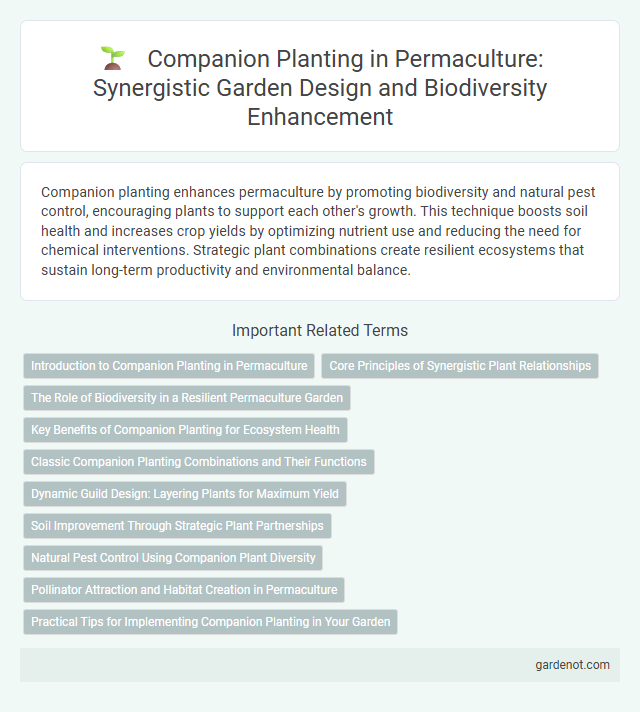Companion planting enhances permaculture by promoting biodiversity and natural pest control, encouraging plants to support each other's growth. This technique boosts soil health and increases crop yields by optimizing nutrient use and reducing the need for chemical interventions. Strategic plant combinations create resilient ecosystems that sustain long-term productivity and environmental balance.
Introduction to Companion Planting in Permaculture
Companion planting in permaculture involves strategically growing different plant species together to enhance growth, repel pests, and improve soil health. By leveraging natural plant relationships, such as nitrogen-fixing legumes paired with nutrient-demanding vegetables, gardeners create balanced ecosystems that increase biodiversity and productivity. This sustainable practice reduces the need for synthetic fertilizers and pesticides, promoting resilient and self-sufficient food systems.
Core Principles of Synergistic Plant Relationships
Companion planting thrives on core principles such as mutual support by combining plants that enhance nutrient uptake, pest resistance, and microclimate regulation. Plants like legumes enrich soil nitrogen, benefiting neighboring crops, while aromatic herbs repel pests and attract beneficial insects, creating a balanced ecosystem. This synergy maximizes biodiversity and soil health, leading to sustainable and resilient permaculture gardens.
The Role of Biodiversity in a Resilient Permaculture Garden
Companion planting enhances biodiversity by integrating diverse plant species that support each other's growth, pest resistance, and nutrient cycles in a permaculture garden. This biodiversity fosters resilience by creating a balanced ecosystem where natural predators control pests, and various plants improve soil health and water retention. A resilient permaculture garden leverages these interactions to reduce dependency on external inputs, ensuring sustainable productivity and ecological stability.
Key Benefits of Companion Planting for Ecosystem Health
Companion planting enhances ecosystem health by promoting natural pest control, increasing biodiversity, and improving soil fertility through complementary plant interactions. This method reduces the need for chemical pesticides and fertilizers, fostering a balanced and resilient garden environment. Beneficial plant combinations attract pollinators and predatory insects, which support sustainable crop production and ecosystem stability.
Classic Companion Planting Combinations and Their Functions
Classic companion planting combinations such as tomatoes with basil enhance flavor and deter pests, while corn, beans, and squash--known as the Three Sisters--support each other by providing structural support, nitrogen fixation, and ground cover respectively. Marigolds planted alongside vegetables release natural nematode-repelling compounds that protect roots and improve soil health. These strategic plant pairings optimize garden productivity, reduce pest pressure, and improve nutrient cycling in permaculture systems.
Dynamic Guild Design: Layering Plants for Maximum Yield
Dynamic guild design in permaculture enhances garden productivity by strategically layering companion plants based on their complementary functions such as nitrogen fixation, pest repellence, and nutrient accumulation. This method promotes sustainable soil health, maximizes space efficiency, and supports diverse beneficial insect habitats. Incorporating root crops, ground covers, shrubs, and canopy trees in a layered system optimizes resource use and boosts overall yield.
Soil Improvement Through Strategic Plant Partnerships
Companion planting enhances soil quality by leveraging plant partnerships that naturally fix nitrogen, improve organic matter, and suppress soil-borne pests. Leguminous plants like clover and beans enrich the soil with nitrogen through symbiotic bacteria, promoting healthier growth for adjacent crops. Strategic combinations, such as deep-rooted plants alongside shallow-rooted companions, optimize nutrient cycling and soil structure, boosting overall permaculture productivity.
Natural Pest Control Using Companion Plant Diversity
Companion planting enhances natural pest control by leveraging plant diversity to attract beneficial insects and repel harmful pests, reducing the need for chemical pesticides. Strategic combinations, such as planting marigolds near tomatoes, deter nematodes and aphids while improving soil health. Diverse plant assemblages create ecological balance, promoting resilient permaculture systems that sustain crop productivity and environmental health.
Pollinator Attraction and Habitat Creation in Permaculture
Companion planting in permaculture enhances pollinator attraction by incorporating diverse flowering plants that provide nectar and pollen across seasons, supporting bees, butterflies, and other beneficial insects. Strategic plant combinations create habitats essential for pollinator nesting and shelter, increasing biodiversity and ecosystem resilience. This approach improves crop yields and health by promoting natural pollination and pest control within sustainable agricultural systems.
Practical Tips for Implementing Companion Planting in Your Garden
Select plant pairs such as tomatoes and basil to enhance growth and deter pests in your garden. Space plants according to their root depth and sunlight requirements to maximize health and yield. Rotate companion planting combinations each season to maintain soil fertility and reduce disease risks.
Companion planting Infographic

 gardenot.com
gardenot.com